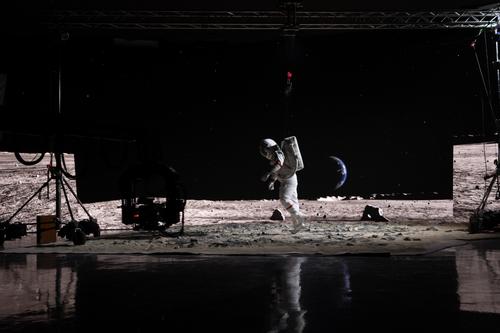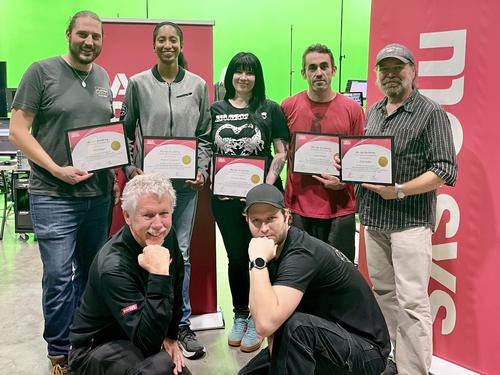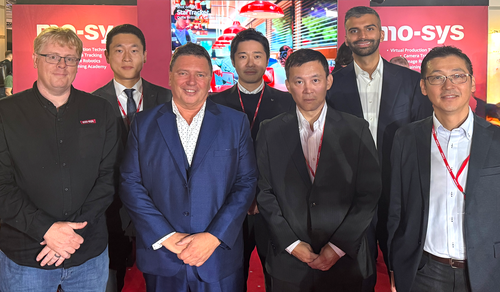Busting the Top 5 Virtual Production Myths
Mo-Sys commercial director Mike Grieve tackles popular misconceptions about the evolution of virtual production in this article by Little Black Book: Busting the Top 5 Virtual Production Myths!
 Busting the Top 5 Virtual Production Myths
Busting the Top 5 Virtual Production Myths
Did you know that Disney+’s The Mandalorian used LED virtual production in order to bring its iconic galaxy far, far, away to life? You did? That’s probably because it seems to be by far the most talked-about example of virtual production, even years after the series first began streaming. But did you also know that The Mandalorian was far from the first time filmmakers used this technology?
While it’s true that the LED volume sets which the show used to create the otherworldly planets for Mando’s adventures were relatively new at the time, computer graphics based virtual production itself was not. In fact, it’s been around since as far back as 1995.
That’s because ‘virtual production’ is a term given to a whole suite of techniques which have been driving progress in the world of filmmaking since its inception. It includes motion capture, green screens, LED volumes, pre-visualisation, and any content production that includes tracked 3D computer graphics.
Tantalisingly, that also means that the aforementioned LED volumes do not represent the peak of virtual production’s potential. In fact, there are boundless ways that the technology can evolve (and is indeed already doing so).
If three decades of working in the production sector have taught me anything, it’s that you need to learn quickly. So, with that in mind, let’s tackle five of the most frequent misconceptions around the quickly-evolving world of virtual production.
Virtual production did not start with the Mandalorian
For all of the excitement currently surrounding virtual production, you’d be forgiven for thinking it was invented just 2 years ago. But if you’ve ever seen a classic Hollywood movie with moving backdrops speeding by a stationary prop car, you’ve witnessed virtual production techniques in action. Whilst we might think of that as primitive today, it’s not too distant a relation from the LED volumes which are commonplace amongst sets utilising virtual production in 2022.
Similarly, you’ve probably also seen virtual production make significant leaps forward in the past couple of decades. Audiences in the 2000s, for example, were captivated by Andy Serkis’ CGI-enabled turn as Gollum in Peter Jackson’s The Lord of the Rings trilogy. Motion capture is another key element of filmmaking technology which we can put under the virtual production umbrella. It also has roots tracing back to the 1960s, when the animator Lee Harrison III experimented with a series of analogue circuits, cathode ray tubes, and adjustable resistors.
So, far from being an entirely new technological innovation, virtual production represents the next step of an evolution which filmmaking has been undergoing since the first cameras started to roll.
Virtual production is NOT expensive
With any cutting-edge tech in film, there’s an expectation that it will initially be the preserve of big-budget Hollywood blockbusters. In the case of virtual production, this is a misconception further cemented by the ubiquity of examples such as The Mandalorian and 2019’s The Lion King.
But, whilst it’s true that virtual production is widely used in Hollywood, its usefulness doesn’t end there. In reality, the technology offers cost savings which will appeal to any production team. Think of it as a re-ordering of the overall production process; your 3D computer graphic assets are now prepared in full quality in pre-production, and your post-production compositing is the shoot itself. The saving is the reduced post-production time and the removal of on-set errors.
Also, the ability to make creative decisions earlier on in the process, will result in cleaner takes given that actors are present whilst those calls are being made, as opposed to fixing costly errors in post (or, even more inconveniently, with re-shoots). On top of that, virtual scouting eliminates the cost of travel and indeed our carbon footprints.
The true magic of virtual production, however, lies in the fact that it is not a cheap substitute for ‘the real thing’ - it is simply an alternative. As a 2020 report from Deloitte noted, “Hollywood may be reaching the limits of efficiency using the traditional production methodology. The mindset and toolset of virtual production can support not only better creative outcomes, but also potentially significant time and cost savings.”
And in this instance, what’s true for Hollywood is true for the rest of the industry, too.
Virtual production doesn’t all happen in a video game engine
In any good myth, there’s normally a hint of truth - and this is a great example. It’s absolutely the case that video game engines (most famously Epic Games’ Unreal Engine and Unity 3D) have provided the basis for many virtual production technologies. This is because these engines produce photo-realistic results and operate in real-time providing the ability to respond to filmmakers’ inputs instantly.
But ultimately, understanding the full picture comes down to the fact that ‘virtual production’ is an umbrella term used to describe a whole suite of filmmaking technologies. As well as these game engines, you also have incredibly practical techniques such as on-set finishing using LED volumes, and the aforementioned motion capture software among many others.
Modern filmmakers have the luxury of choosing from so many different virtual production techniques to bring their projects to life, from LED volumes to comparatively old-fashioned green screens, or even shooting with both simultaneously.
Virtual production wasn’t a solution to the pandemic
Like so many other things, virtual production’s use on film sets was accelerated - but not invented - by the pandemic. And it’s a certainty that these techniques will stick around as part of the industry long after lockdowns descend into memories.
Certainly, the remote capabilities of many virtual production technologies were the perfect solution to the restrictions of the past two years, and many filmmakers took advantage of them. But virtual production’s utility obviously extends well into the future.
In light of parallel advancements in technology - most notably the metaverse - there’s every reason to believe that virtual production will soon be (if it isn’t already) a staple in the toolkit of every filmmaker. To return to a familiar theme, the fact is that virtual production is not a compromise, it’s a set of tools which can elevate any filmmaking project.
Virtual production does not end with LED Volumes
Finally, perhaps the most important truth about virtual production is that it is, like any technology, constantly evolving and improving. Within our team at Mo-Sys, we’re seeing new innovations such as our patent-pending Cinematic XR Focus, which allows focus pulls between talent and a virtual object/avatar positioned virtually behind the plane of the LED wall. Think of what ‘digital doubles’ is and where this technology is heading, and you’ll see the relevance of Cinematic XR Focus.
Above: An explainer breaking down Mo-Sys’ new Cinematic XR Focus
And this is just one example of the potential which today’s virtual production technology has in store. Indeed, at Mo-Sys we are currently working on even more ways to build on what we’ve already achieved in the realm of virtual production. From smarter collaboration on a global scale, to even more integrated filmmaking allowing for truly interactive storytelling, our industry has yet to scratch the surface of what virtual production can achieve.
These are the ‘known unknowns’, and they’re precisely what makes virtual production so exciting. While we may not be able to predict exactly how the technology will evolve in the future, one thing’s for sure: filmmakers will be the winners.




